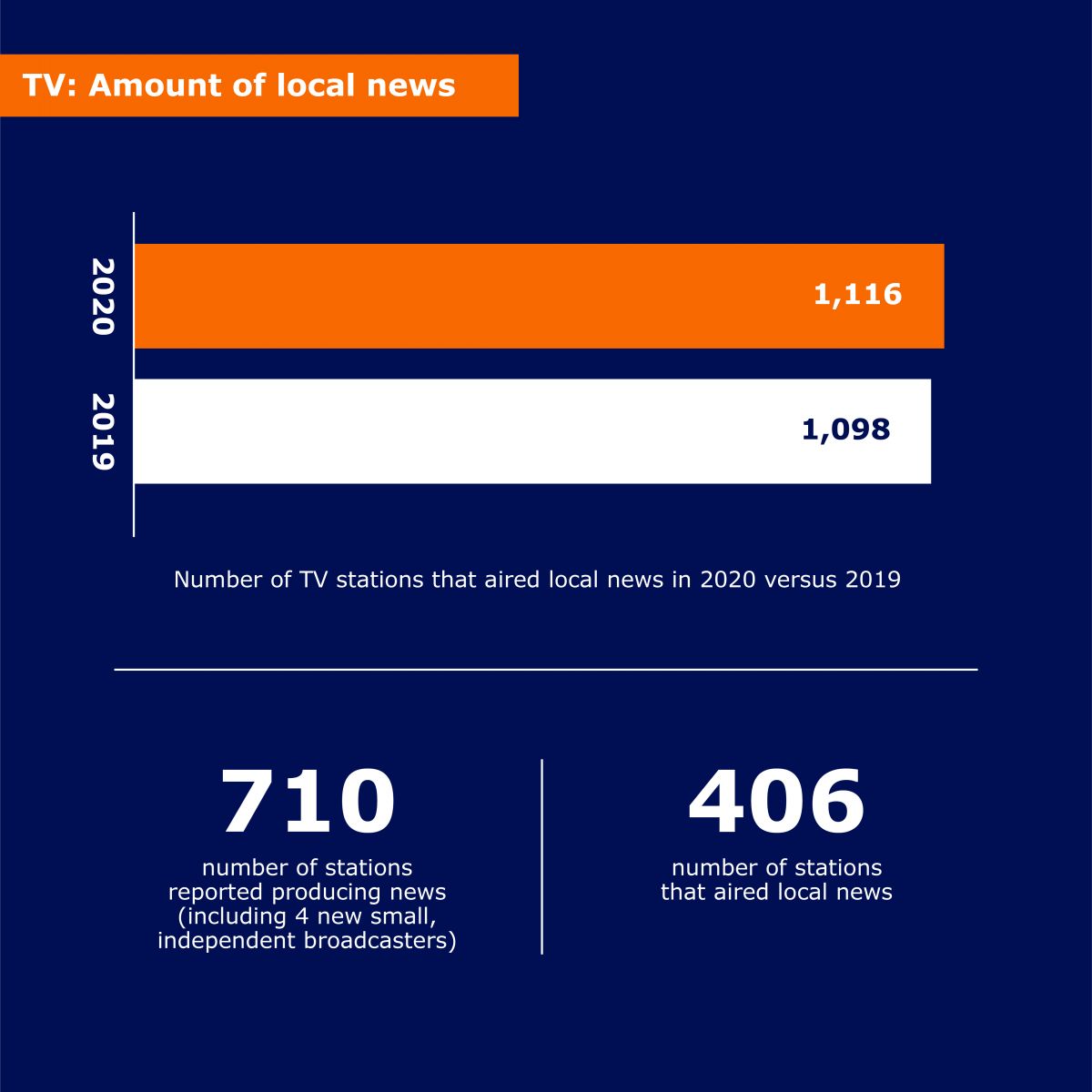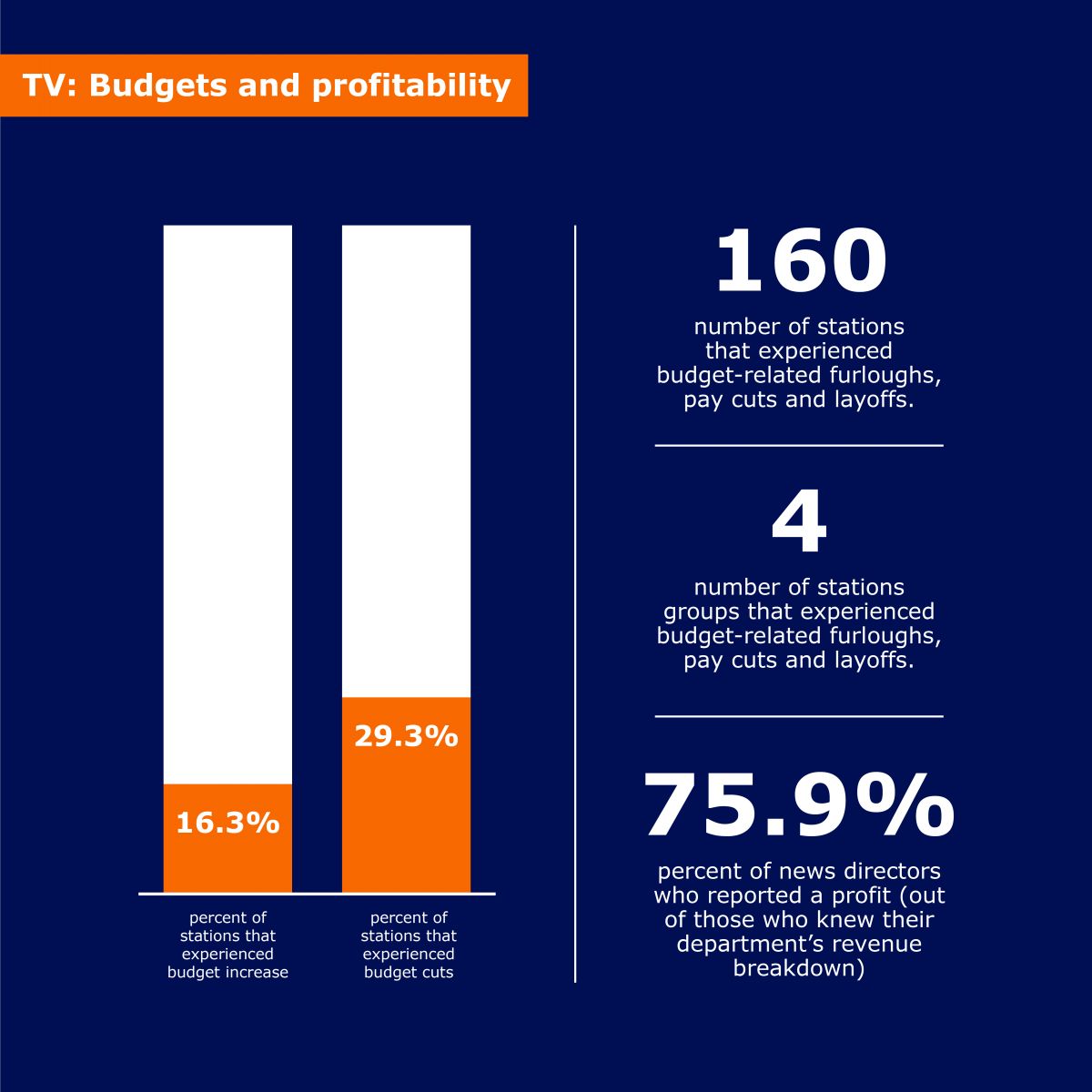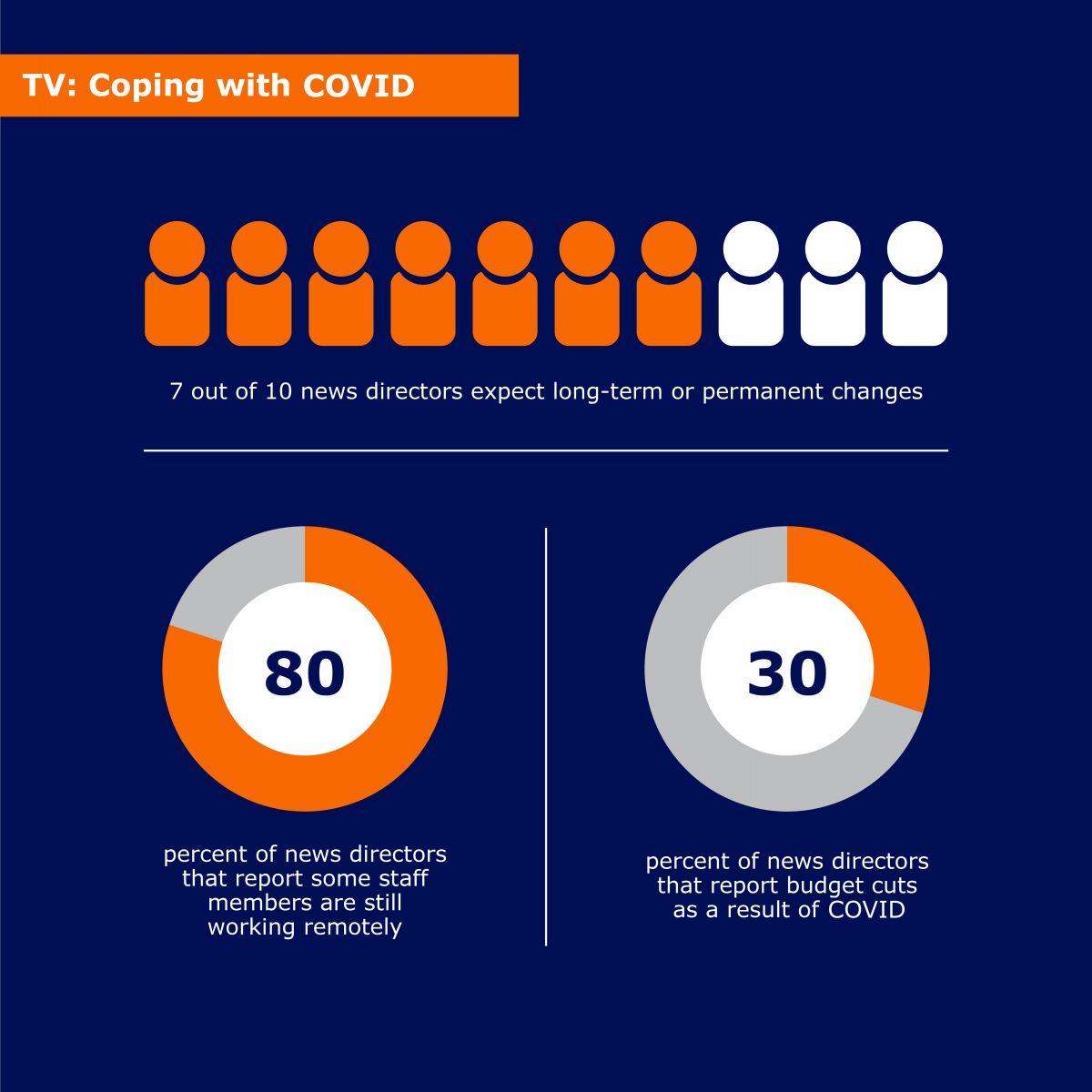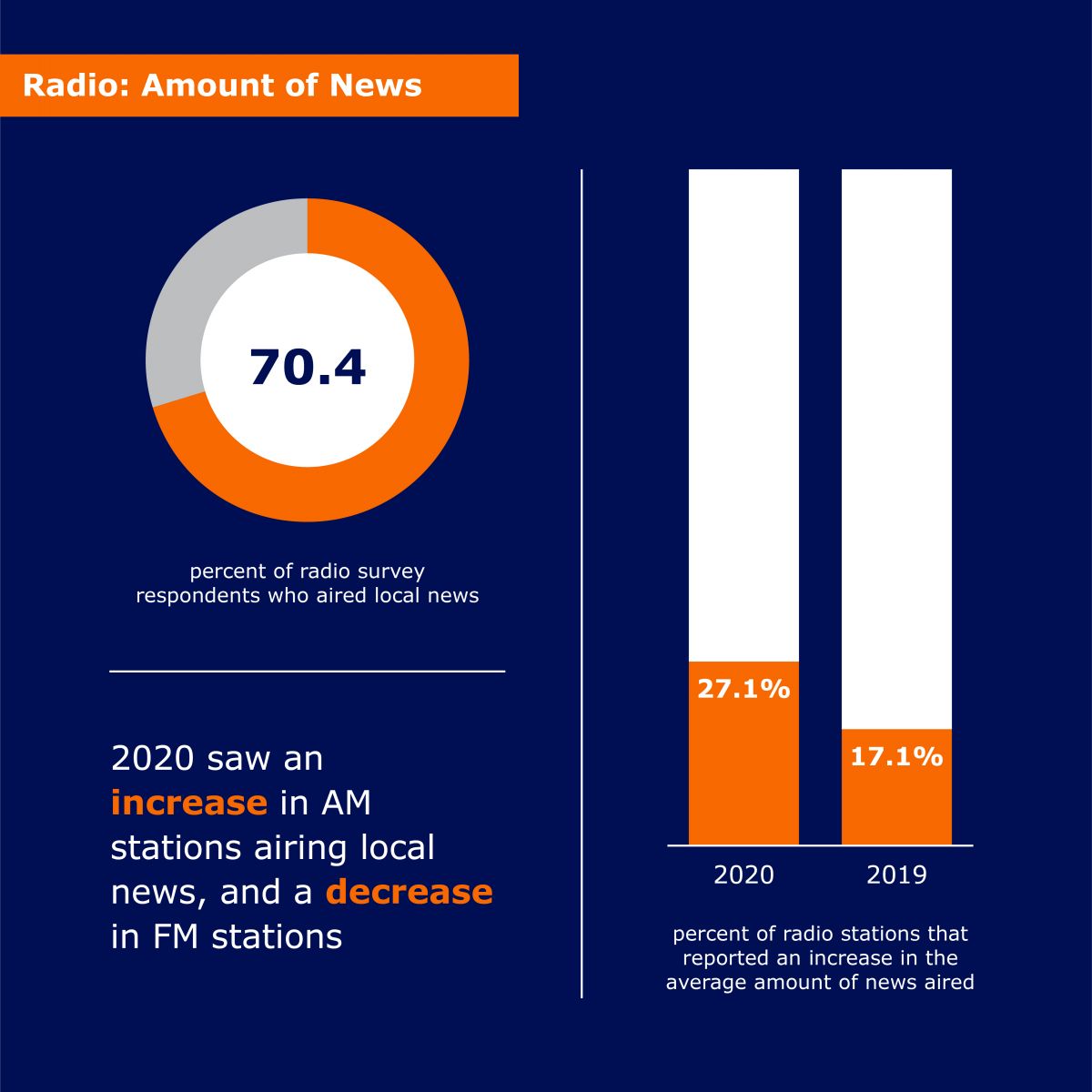More Stations Produced More Local News Than Ever During 2020

TV
Despite facing revenue shortfalls, budget cuts and unprecedented operational challenges, local TV stations aired more news in 2020 than ever recorded by the RTDNA newsroom survey.
2020 saw a record amount of local TV news for the second year in a row. In addition, a record number of stations are running local news.
Amount of Local TV News
 A new record of 1,116 TV stations aired local news in 2020, up 18 from last year’s all-time high. 710 stations reported producing news, up 5 including 4 small, independent broadcasters. 406 additional TV stations aired local news, up 13 from 2019.
A new record of 1,116 TV stations aired local news in 2020, up 18 from last year’s all-time high. 710 stations reported producing news, up 5 including 4 small, independent broadcasters. 406 additional TV stations aired local news, up 13 from 2019.
Stations also aired another record amount, in hours, of local news. Increases in weekday news offset slight decreases in weekend news for an overall net gain in average hours of local TV news. 34.5% of TV stations report they increased the amount of news they aired in 2020, 7.3 percentage points more than in 2019.
On average, stations in all market sizes and all staff sizes of 21 or more increased the amount of news in minutes. Among network affiliates, news time on air increased for all except Fox. CBS stations were most likely to increase the amount of news from 2019. Given 2020’s increases, fewer news directors expected further increases in 2021.
TV News Budgets and Profitability
2020’s growth in the amount of news produced came amid a year of cutbacks for news budgets. Just 16.3% of TV stations report budget increases in 2020 versus 36.8% that did in 2019. 29.3% report experiencing budget cuts in 2020 vs 9.1% that did in 2019. Stations in the top 50 markets were most affected by budget cuts.
 The Tow Center COVID-19 Newsroom Cutback Tracker reports budget-related furloughs and pay cuts as well as layoffs among at least 4 stations groups and 160 stations during 2019.
The Tow Center COVID-19 Newsroom Cutback Tracker reports budget-related furloughs and pay cuts as well as layoffs among at least 4 stations groups and 160 stations during 2019.
Fewer news directors report their news departments were profitable in 2020 than in 2019, and more report losses by their departments and by news websites. More were also unsure of their department’s bottom line. Declines in profitability were reported across market and staff sizes and network affiliation.
Among TV news directors who do know their department’s profitability, 75.9% report a profit.
As news profitability decreased, the percentage of station revenue generated by the news department remained steady, though most news directors (77.7%) didn’t know their station’s revenue breakdown.
However, to look at the bigger picture of the business of TV news during 2020, the Pew Research Center reports that, for local TV news, the loss of ad revenue in the pandemic’s early days didn’t exceed gains in retransmission revenue. Mixed revenue pictures among major TV groups largely resolved into double digit year-over-year revenue increases for the second half of 2020. Several groups set record revenues, with gains of 25 to 40 percent, with some significant exceptions.
Coping with COVID
 COVID has had a stark and lasting impression on local TV newsrooms, with more than 90% of TV news directors reporting their newsrooms were still feeling significant impacts as 2020 ended. More than 80% report at least some staff remain remote, a move that may in some cases be permanent. Stations with more staff and those in bigger markets were most likely to have staff continuing to work remotely.
COVID has had a stark and lasting impression on local TV newsrooms, with more than 90% of TV news directors reporting their newsrooms were still feeling significant impacts as 2020 ended. More than 80% report at least some staff remain remote, a move that may in some cases be permanent. Stations with more staff and those in bigger markets were most likely to have staff continuing to work remotely.
30% report budget cuts and nearly as many have reduced staff sizes in their newsrooms, with stations in the Northeast most affected by staff reductions or furloughs.
Seven of 10 news directors expect long term or permanent changes, particularly those in larger markets or larger newsrooms. Anticipated permanent changes focus on workflow, including fewer staffers using the newsroom as a “home base,” more remote meetings and virtual interviews. Several news directors noted the increased stress from smaller teams, while others noted the upsides of improved virtual work options.
Radio
Amount of Radio News
 More radio stations report running local news in 2020, with an increase among AM stations offsetting a slight decrease among FM stations. 70.4% of radio survey respondents overall report airing local news, though stations with news may be more likely to participate in the survey.
More radio stations report running local news in 2020, with an increase among AM stations offsetting a slight decrease among FM stations. 70.4% of radio survey respondents overall report airing local news, though stations with news may be more likely to participate in the survey.
Radio stations aired more minutes of news in 2020 as well, with a slight increase in average minutes of news. 27.1% of radio stations report an increase in the amount of news they aired, up by more than 10 percentage points from 2019. Larger stations, stations in larger markets and public stations were most likely to produce more news.
Radio News Budgets and Profitability
While more than half of radio news managers report their budgets did not change in 2020, the percent saying their budgets decreased doubled to 18.2%. More radio departments reported cuts across market and staff sizes.
Radio profitability was down slightly but more stable than TV profitability, though just over 40% of radio managers didn’t know their department’s profitability. 12.4% reported a loss in 2020 versus 7.3% in 2019. On the other hand, radio website profitability was up slightly, driven by growth in major markets, though close to 60% weren’t sure of their website’s profitability.
 The Tow Center COVID-19 Newsroom Cutback Tracker reports budget-related cutbacks in more than 700 radio newsrooms, including company-wide cuts to staffing, programming or hours for at least 8 major station groups. More in the upcoming staffing/hiring survey report.
The Tow Center COVID-19 Newsroom Cutback Tracker reports budget-related cutbacks in more than 700 radio newsrooms, including company-wide cuts to staffing, programming or hours for at least 8 major station groups. More in the upcoming staffing/hiring survey report.
Just under a quarter of radio managers knew how much of their station’s revenue comes from news, but of those that do report numbers consistent with past years, with a median around 5% and average closer to 13.4%.
Coping With COVID
COVID had noticeably different and mixed impacts in local radio news compared to TV. 8% of radio respondents report coronavirus or the associated economic disruption ended their local news programs altogether. Major markets and public radio stations were more likely to be affected.
In contrast, just over 40% of radio respondents report no ongoing significant impacts to their stations. Among those that do, maintaining remote staff was the most reported impact.
 70% of radio news managers expect no meaningful long-term changes. Remote work is again the most reported impact among those expected ongoing changes. Given a typical radio news department includes just one full-time employee, this could account for the relatively low reports of ongoing impact.
70% of radio news managers expect no meaningful long-term changes. Remote work is again the most reported impact among those expected ongoing changes. Given a typical radio news department includes just one full-time employee, this could account for the relatively low reports of ongoing impact.
Bob Papper is Adjunct Professor of Broadcast and Digital Journalism at Syracuse University and has worked extensively in radio and TV news.
About the Survey
The RTDNA/Newhouse School at Syracuse University Survey was conducted in the fourth quarter of 2021 among all 1,780 operating, non-satellite television stations and a random sample of 3,379 radio stations. Valid responses came from as many as 1,336 television stations (75.1%) and 765 radio news directors and general managers representing 2,310 radio stations. Some data sets (e.g. the number of TV stations originating local news, getting it from others and women TV news directors) are based on a complete census and are not projected from a smaller sample.
